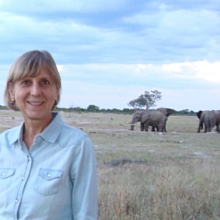The impact of the program on empowering communities has been significant: 75 conservation-compatible enterprises were created (such as ecotourism, beekeeping and crafts), 185 people were trained in business development, 77 young people were given scholarships to attend courses, and 393 local leaders applied skills from the training provided in resource management to improve co-management of the park (communities working jointly with the government to protect the area).
Vumasa was one of the 77 students of the Higher Education Access Program that supported students with financial, psychosocial, and academic support. Vumasa currently leads an environmental educational program within the community that identifies and labels trees, hosts students visiting the iSimangaliso Wetland Park, facilitates environmental awareness workshops with youth, and supports a project to increase the skills of tour guides.
“It makes me happy because I am using the knowledge that I obtained from my father (who was a traditional healer), and I never thought that along the way I could make a living out of it... I am now transferring the knowledge that I have to other people, like the youth,” said Vumasa.
He is also inspiring others: “There are people in town who when I meet them they would say to me, ‘I decided to pursue a career in nature conservation or in tourism after attending your field trip.’”
Although the project has created many jobs and opportunities, unemployment around iSimangaliso remains high and there is still a long way to go to engage the active population around the park. The World Bank continues discussing opportunities for collaboration on rural development around South Africa’s protected areas with the Department of Environmental Affairs, the iSimangaliso Wetland Authority and other partners.
The story behind the restoration of iSimangaliso Wetland Park
Since 1952, measures were taken to partially separate the uMfolozi River from the Lake St. Lucia Estuary by depositing dredge spoil between them and artificially breaching the uMfolozi River into the sea. This significantly reduced freshwater to Lake St. Lucia from the uMfolozi River as a result of freshwater from the river being dumped into the sea instead of recirculating into the lake. South Africa is already a water scarce country and for the past three years has been experiencing its worst drought on record.
A multi-disciplinary scientific study was carried out with GEF-funding. It demonstrated that to address the issues and improve the health of the Lake St. Lucia system, the uMfolozi river needed to be reconnected to the larger estuary through significant infrastructure work. Through project investments of $46 million from government funds and private donors, approximately 1.4 million m3 of dredge spoil was removed to clear the natural course of the uMfolozi River and relink it to the Lake St. Lucia system. This restored the hydrological and estuarine functions of the Lake.
The project’s objectives aligned with South Africa's 2015 National Biodiversity Strategy and Action Plan priorities, including the need to tackle the root causes of biodiversity loss, and also compliment South Africa's National Development Plan 2030, which aims to introduce policies to reduce inequality and improve job creation.
Other World Bank initiatives promoting conservation and livelihoods
The World Bank-led, GEF-funded Global Wildlife Program (GWP) is also supporting enhancing community livelihoods, wildlife conservation, and sustainable development through its work across 19 countries in Asia and Africa to tackle the illegal wildlife trade by reducing poaching, trafficking and demand.
Also with GEF funding, the GWP and the World Bank published Supporting Sustainable Livelihoods through Wildlife Tourism in April, which highlights successful wildlife tourism programs in seven countries in Africa and Asia that can be used as models to promote conservation and boost economies.
And in June the government of Mozambique, together with the GWP and the World Bank, held a first-of-of its-kind conference to transform the landscape of Mozambique by focusing on nature-based tourism. Eight memorandums and agreements—totaling approximately $600 million in investments—were signed to facilitate PPPs in conservation areas.
* The GWP would like to thank Bronwyn James and Debbie Cooper from the iSimangaliso Wetland Park Authority for their contribution to this feature story.



